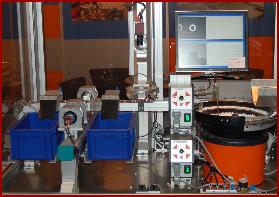 | ||||||||||||||||||||||||||||||||||
Doktor Jons Guide to the "Use and Application of CCTV" | ||||||||||||||||||||||||||||||||||
 | ||||||||||||||||||||||||||||||||||
 | ||||||||||||||||||||||||||||||||||
 | ||||||||||||||||||||||||||||||||||
- Press Release - 16th January 2009 | ||||||||||||||||||||||||||||||||||
Photo reproduced by kind permission of AVT | ||||||||||||||||||||||||||||||||||
Even for small mass-produced parts, it is worth it to use industrial image-processing systems to guarantee first-class quality. At NP Plastics, small plastic rollers for document binders are checked 600 times per minute in three dimensions with digital cameras from Allied Vision Technologies. You see rows of them lined up in almost every office: document binders in various formats. The fine lever mechanics of these folders also ensure that when they are full, the rings are solid and stable when closed and make it simple to open and close them without a great deal of force. Who would have thought that the small plain plastic rollers in this closing mechanism, produced by the millions, were checked for perfect quality with sophisticated image-processing technology? But that is the only way to guarantee that these binders can stand up to the strain of daily office use year after year. To NP Plastics, an experienced Dutch manufacturer of injection-molded plastic parts, the perfect quality of the small white rollers was worth the investment in an image-processing system. The challenge was to check the geometry of the approx. 5-mm rings for defects and sharp edges (or burrs) at a rate of at least 600 parts per minute. Checking 600 Parts per Minute The first step is to sort the many plastic rings and put them in order for checking. This is done with a vibrating feed system. The rings are lined up on a conveyor belt and spaced a minimum of 4 cm apart. This is the only way to guarantee reliable measurements. The precision with which the small rollers lie on the conveyor belt is determined randomly: there is no predetermined top or bottom; the angle of incidence of the axis is also completely random. Despite this random arrangement, the system relies on two cameras that take snapshots at two different viewing angles to find defects in the geometry of the rings. The first camera hangs over the conveyor belt and checks the rings from above. The outer and inner diameters are measured first. A second digital camera is installed on the side of the conveyor belt and checks the outer circumference of the rollers. By measuring the height of the part, defects can be identified that are not visible from the top perspective. Both cameras are triggered by a photo cell directly over the I/O port that detects the presence of a ring on the conveyor belt. This guarantees that each individual part is detected with precision. “For this application, we need fast, sensitive digital cameras that can deliver clear sharp images during the production of over 600 parts per minute,” explains Maarten Bruin, who is responsible for the project at Radine. “This corresponds to an image frequency of 10 fps at full resolution. Since the objects being checked are on a moving conveyor belt, a short exposure time (max. 85 µs) is also crucial to prevent blurring due to motion.” Fast Image Acquisition for Immediate Reaction The images are analyzed rapidly in the PC by an MVTec Halcon-based software application that compares them with typical defect patterns. Burrs and irregularities are recognized immediately, and defective parts are automatically rejected by compressed air even before they reach the next testing station. This system is in operation at NP Plastics 24 hours a day. “We are especially proud of this sophisticated image-processing solution,” says Bas H. Pot, who supervised the project at NP Plastics. “With this system, we can guarantee our most demanding clients that, even when millions of them are produced, each individual plastic roller that leaves our factory has had a complete check-up.” About Allied Vision Technologies For details visit:- http://www.alliedvisiontec.com - Ends - | ||||||||||||||||||||||||||||||||||
 | ||||||||||||||||||||||||||||||||||
 | ||||||||||||||||||||||||||||||||||
IMPORTANT: No material may be reproduced, copied or redistributed from this site, All the detailed information on this site is provided in good faith; as such, Doktor Jon does not accept responsibility for any consequential loss, injury or disadvantage resulting from any individual or organisation acting on the details contained herein. © doktorjon.co.uk 2004 - 2009 | ||||||||||||||||||||||||||||||||||
Homepage...:...Gateway...:...Technical Gateway....:....Quickfind Index....:....Equipment Directory | ||||||||||||||||||||||||||||||||||